善徳寺 虫干法会 Mushiboshi Ceremony 7.22〜28
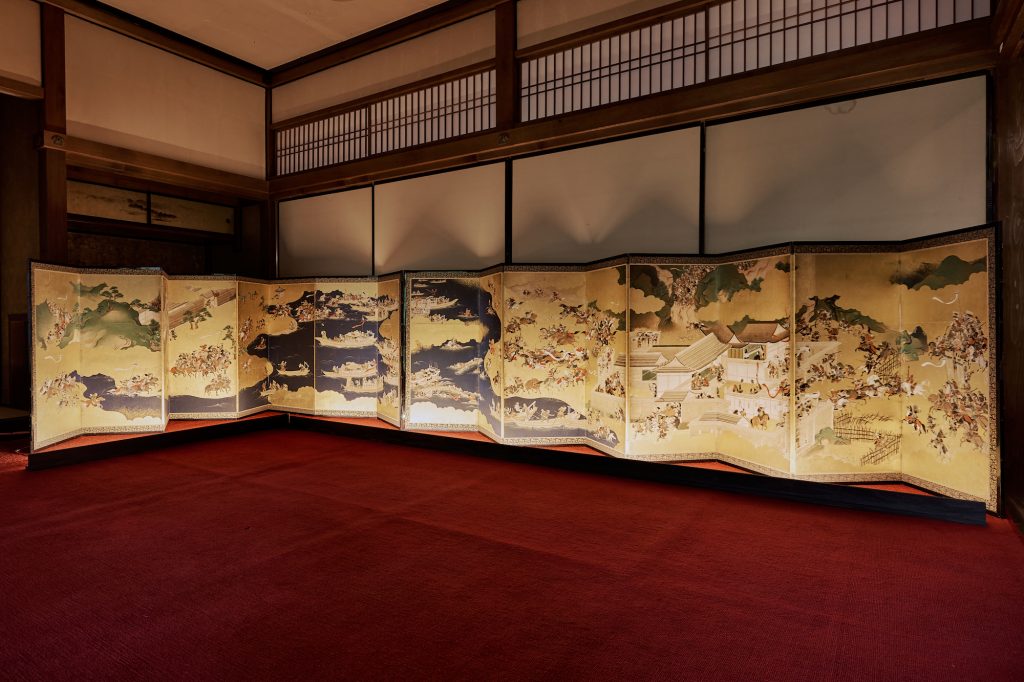
毎年7月下旬に開催される「虫干法会(むしぼしほうえ)」では宗祖・親鸞聖人直筆の「唯信鈔断簡」をはじめ、什宝物・法宝物・古文書など、約1万点の寺宝の中から約500点を1週間にわたって一般公開している。また、善徳寺は「民藝運動」の創始者・柳宗悦が62日間滞在した「民藝の聖地」でもあり、棟方志功や浜田庄司、河井寛次郎など民藝作家の作品も多数保有している。柳が滞在した「お広敷の間」でそれらを展示公開している。
展示のほか、蓮如上人の一生を解説する絵解き、善徳寺特製の名物・さばずしを味わうこともできる。
During the “Mushiboshi-Hoe Ceremony” held in the end of July every year, around 500 out of approximately 10,000 temple treasures, including the original handwritten “Yuishin-sho” by the founder Shinran Shonin, as well as various precious objects, artifacts, and ancient documents, are open to the public for one week. Zentoku-ji Temple is also known as the “Sacred place of Mingei(Japan Folk Crafts)” where the founder of the Mingei Movement, Yanagi Soetsu, stayed for 62 days. The temple also houses numerous artworks by Mingei artists. In addition to the exhibitions, visitors can enjoy storytelling with hanging scrolls illustrating the life of Rennyo Shonin and savor the famous local specialty called “Sabazushi(Fermented Mackerel)” made in Zentoku-ji Temple.
寒山拾得 Hanshan and Shi De
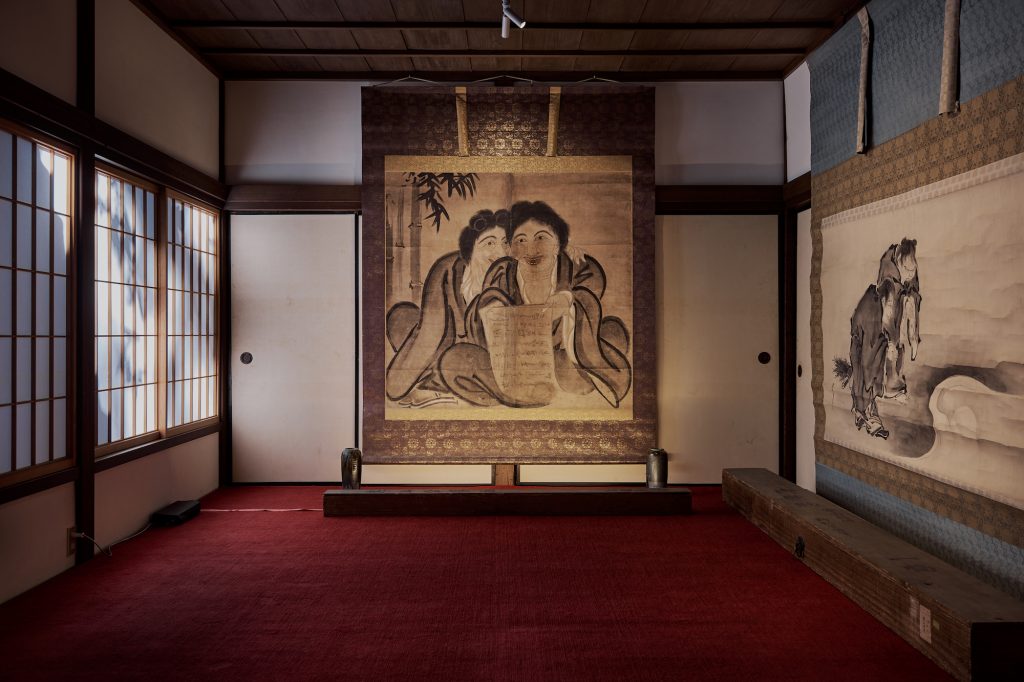
寒山と捨得はおよそ1,300年前、日本の奈良時代に生きておられた中国の高僧と伝えられている。天台宗国清寺の豊干禅師に弟子入りされ難しい修行や、学問に励まれ、後に神通力を得たという。特に寒山は優れた智慧の持ち主で、世間では、文殊菩薩の化身と尊敬され、中国を広く伝道教化されたと言われている。
この絵は、今から600年程前、淡路島生まれの兆殿司により描かれた。寒山拾得図を描いた後、兆殿司は京都の東福寺を中心として、各お寺の壁画を重点的に描いた為、この様な掛軸に描いた絵は少ないと言われている。
It is said that around 1,300 years ago, Hanshan and Shi De were Chinese high priests who lived during Japan’s Nara period. They were skilled practitioners of the Tendai school and underwent rigorous training and study under the guidance of Master Bukan at Kokusei-ji Temple. They later gained supernatural powers. In particular, Hanshan was known for his exceptional wisdom and was respected as an incarnation of Bodhisattva Manjushri. It is said that he extensively propagated Buddhism throughout China.
This painting, created approximately 600 years ago by Chouden- su, born in Awaji Island. After completing the “Hanshan and Shi De” painting, Choudensu focused on creating wall paintings for various temples, it is said that such hanging scroll type of work is rare.
郷倉千靭 Senjin Gokura
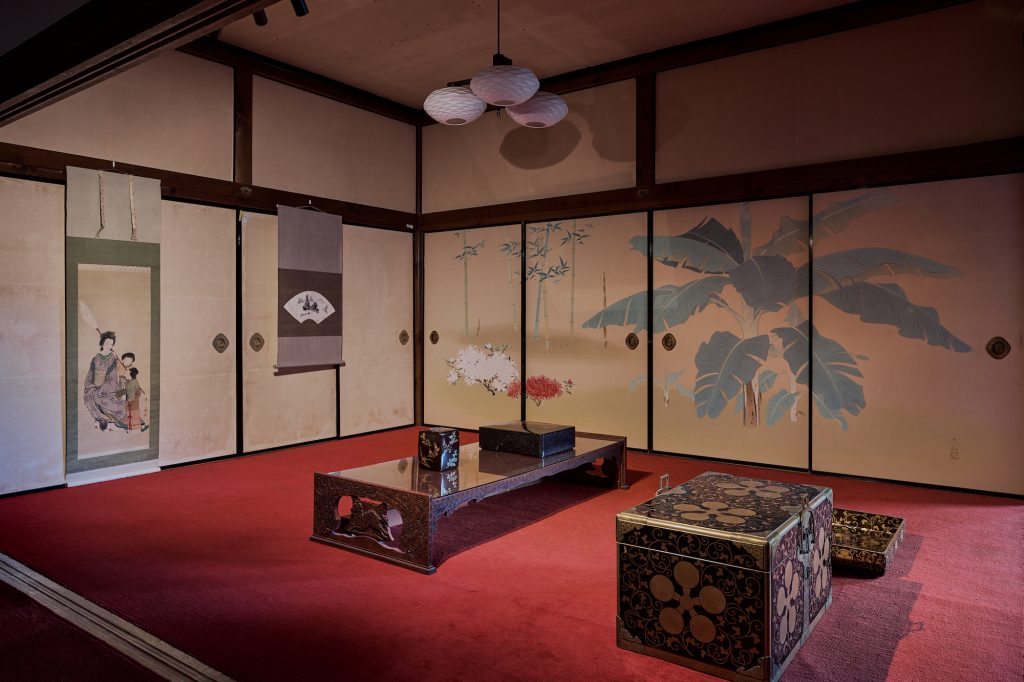
明治25年、富山県射水市生まれの日本画家。東京美術学校(現東京藝術大学)日本画科卒業後、日本美術院展覧会(院展)を舞台に活躍、83歳で亡くなるまで、自然や動植物への親愛の情や、仏教への崇敬、中国や西域の神話への憧憬を込め、確かな写実と斬新な装飾性、明澄な色彩により、ロマンあふれる清麗温雅な作品世界を築き上げた。
総数十六面のこの大作(写真は一部)は、千靱が得意とする花鳥画であり、昭和18(1943)年に善徳寺のために描かれた。春夏秋冬の草花を明るく伸びやかに描ききった秀作であり、中期の集大成を、いわば郷里の聖堂に献上した千靱は、いよいよその画風の様式も名声も不動のものとしていった。
Senjin GOKURA, born in 1905 in Imizu City, Toyama Prefecture, was a Japanese painter. After graduating from the Nihonga (Japanese-style painting) department of Tokyo School of Fine Arts (now Tokyo University of the Arts), he gained recognition through the Japan Art Institute Exhibition (Nitten). His paintings exude a sense of romance, depicting his deep affection for nature, plants, and animals, reverence for Buddhism, and admira- tion for Chinese and Western mythical narratives. His works are characterized by a delicate realism combined with innovative dec- orative elements and bright, clear colors.
This masterpiece, consisting of a total of sixteen panels, show- cases Senjin’s expertise in floral and bird paintings. They were created in 1943 for Zentoku-ji Temple. This exceptional work vivid- ly depicts the seasonal flowers in a bright and graceful manner, representing the culmination of Senjin’s mid-career style. By dedicating this achievement to his hometown temple, Senjin established both his artistic style and reputation in the art world.
貝覆(かいおおい) Shell-matching Game
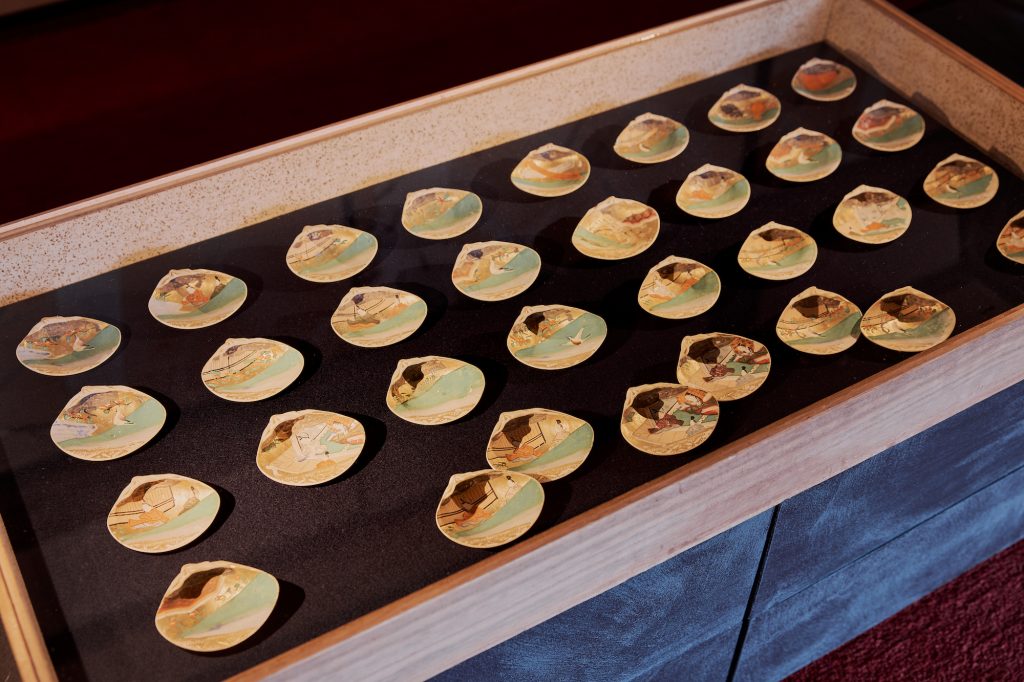
平安時代からおもに貴族の間で遊ばれた室内遊戯で、蛤(はまぐり)の貝殻が一対だけしかはまり合う相手がないという特性を利用した遊びである。江戸時代に加賀藩主・前田家との関わりを深めた善徳寺は、藩主の子息や息女を迎えており、前田家や大名の調度品を数多く保有している。この雅な貝覆もその一つ。
This is a game that was mainly played among the aristocrats from the Heian period, utilizing the unique characteristic that only a pair of clam shells fit together, without any other suitable matches. The Zentoku-ji Temple, which deepened its relationship with the Kaga domain lord, the Maeda family, during the Edo period, welcomed the lord’s sons and daughters and possessed many furnishings from the Maeda family and other daimyo. This elegant clamshell game is one of them.
一の谷・屋島合戦図 The Battles of Ichinotani and Yashima
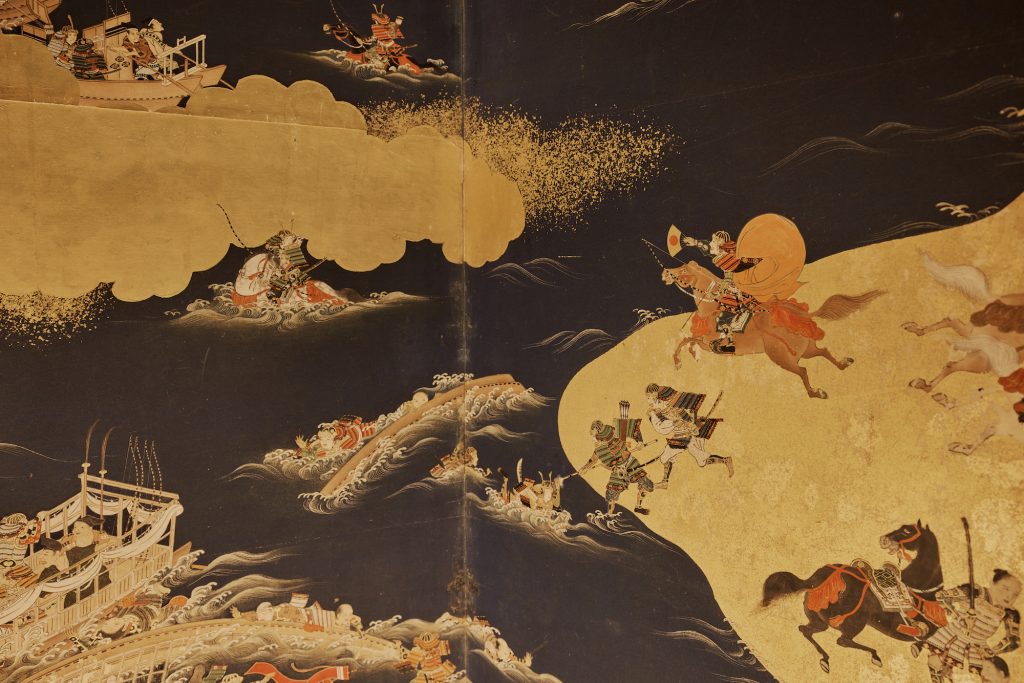
八曲一双という横長の画面のなかに源平合戦の「一の谷合戦」と「屋島の合戦」が描かれており、「鵯越の逆落とし(ひよどりごえのさかおとし)」「弓流し」など源氏の御曹司九郎義経が活躍する名場面が各所に描かれているが、このように同一人物が異なる時間でありながら同じ画面に何度も登場する図を異時同時図という。この日本画独特の構図画法は、現代のアニメーションにも通じ、連続する場面を違和感なくまとめるのも絵師の画力の見せ所であった。
人物や装束を丁寧に細やかに描き分けて描写する画力、また使用されている岩絵具と装丁の上質性と八曲一双という仕立ての高級感、そして加賀前田家と城端別院善徳寺の親密な関係などから、この屏風は当時の支配階級の人物が一流の画家に制作を依頼して作らせ所蔵していたのではないかと考えられる。
This folding screen depicts two famous battles from the Genpei War, “The Battle of Ichi-no-Tani” and “The Battle of Yashima,” within a horizontally elongated frame known as “Yamakage Ichisou.” Scenes of Minamoto no Yoshitsune, the son of the Genji clan, performing notable feats such as “Hiyodorigoe no Sakaotoshi” (the reversal at Hiyodori Pass) and “Yumi Nagashi” (floating the bow) are depicted throughout. This technique, where the same character appears multiple times on the same screen at different moments, is called “Ijidoji” in Japanese. This unique composition method in Japanese painting translates well into contemporary animation, showcasing the artist’s ability to seamlessly blend successive scenes without discordance.
The meticulous portrayal of characters and their attire, the use of high-quality pigments and elegant design, along with the close relationship between the Maeda clan of Kaga domain and Johana Betsuin Zentoku-ji Temple, suggest that this folding screen might have been commissioned and cherished by the ruling class of the time, entrusted to a top-tier artist for its creation.
茶道具 Tea Utensils
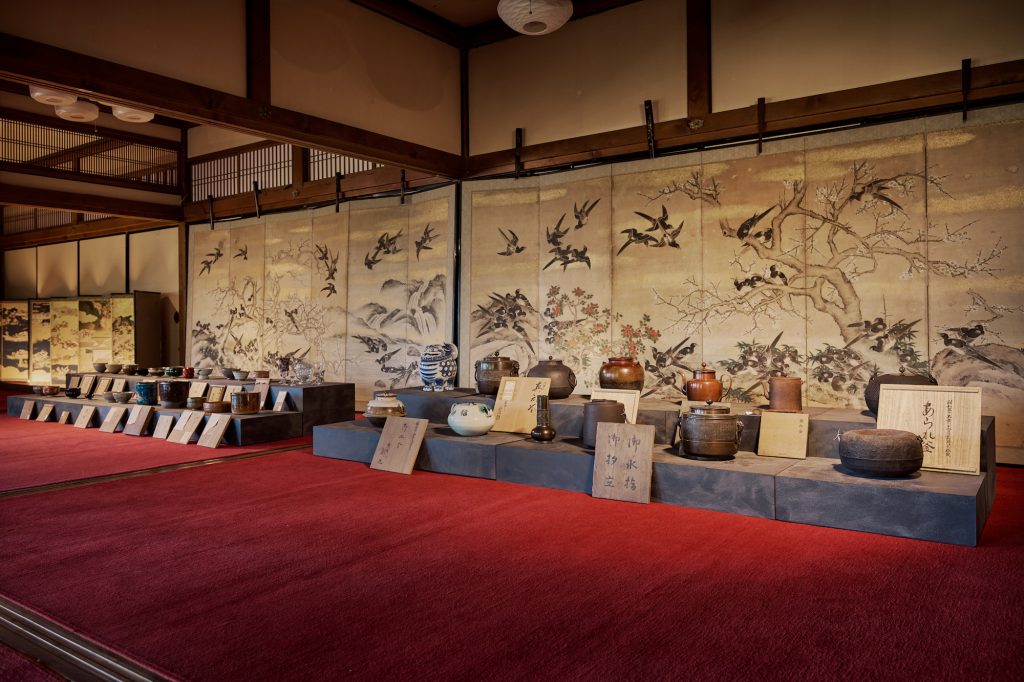
善徳寺内には、築250年以上と言われる侘びた茶室がある。裏千家の代表的な茶室「又隠(ゆういん)」の写しで、兼六園を造園した加賀藩御用達の庭師・駒造が手がけた庭の中に佇む。そこで使用されてきたであろう、江戸時代から民藝の作家まで茶道具の名品も数多く展示される。
Within Zentoku-ji Temple, there is a simple tea room believed to be over 250 years old. Modeled after the famous tea room “Yuuin” of the Urasenke school, it stands within a garden crafted by Komazou, the garden designer appointed by the Kaga Domain, who also designed the Kenrokuen Garden in Kanazawa. Many excellent tea utensils, from the Edo period to contemporary folk artists, are exhibited, likely having been used there over the years.
亮麿様愛用木馬 Sukemaro’s Beloved Wooden Horse
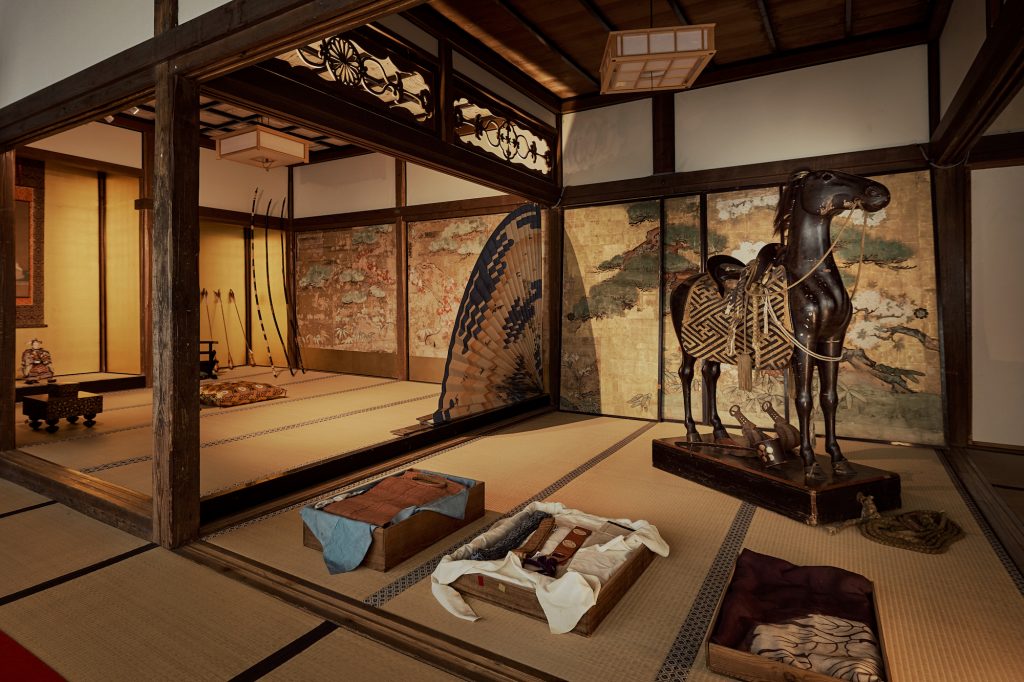
加賀藩第十三代藩主前田斉泰の子、亮麿が善徳寺第十六代住職として、わずか2歳で入寺した際に持参された木馬。わずか四歳で病死した後、その死を悲しんで夜な夜な寺内を走り回ったため、片目をくりぬいたところおさまった、という言い伝えが残っている。漆塗り、金唐皮、銀で加賀象嵌が施されたあぶみなど、美術工芸品としても優れており、加賀藩の「御細工所(おさいくしょ)」で御用職人が手がけたものと推察される。
虫干法会では、前田家2代目藩主・前田利長が宿泊したとされる、善徳寺で最も古い「大納言の間」に亮麿の他の調度品と共に展示される。
Sukemaro, the son of the 13th lord of the Kaga Domain, Nariyasu Maeda, entered Zentoku-ji Temple as its 16th head priest at the tender age of two, and this wooden horse was among his posses- sions at the time. Tradition has it that after Sukemaro passed away at the young age of four, the wooden horse, grief-stricken by his loss, would run through the temple at night. It is said that the horse’s restless behavior finally ceased after one of its eyes was gouged out. This horse is a remarkable art craft, adorned with lacquer, gold karakawa, stirrups with Kaga inlay work in silver, suggesting it was crafted by skilled artisans from the Kaga Domain’s “Osai-kusho” (Imperial Workshop).
During the Mushiboshi Houe ceremony, this wooden horse is displayed along with other furnishings of Sukemaro, in the oldest chamber of Zentoku-ji Temple, known as the “Dainagon no Ma,” where it is believed that Maeda Toshinaga, the second lord of the Maeda clan, stayed.
色紙和讃 三冊 Shikishi Wasan (Buddhism Hymns) Three Volumes
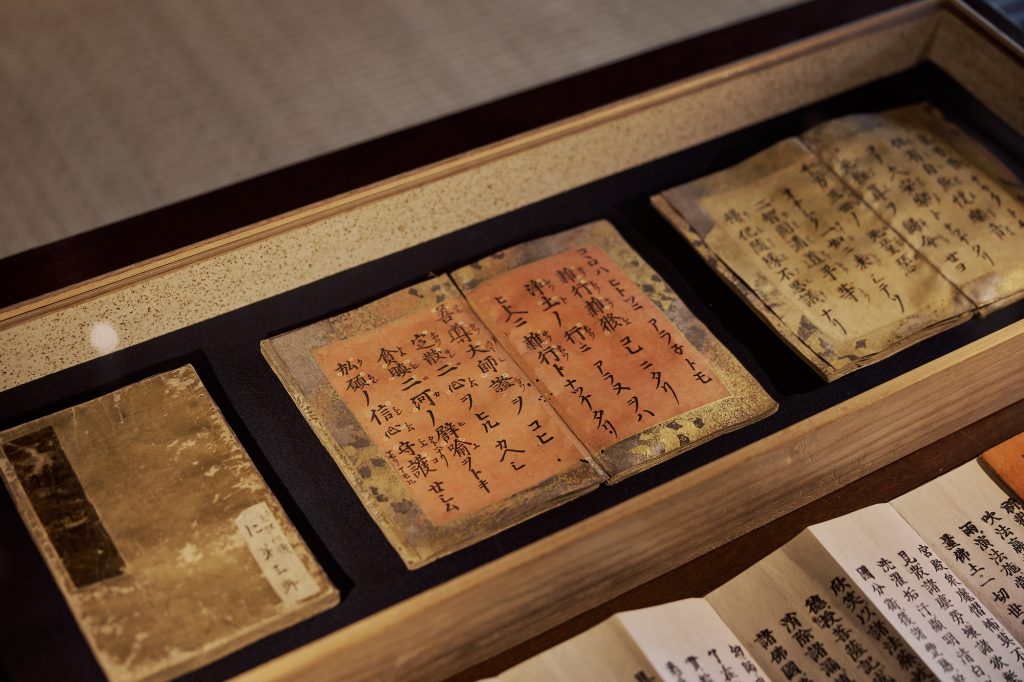
紙本木版墨刷。親鸞聖人の述作による浄土・高僧・正像末の三帖和讃を、美麗な色紙に木版印刷されたもの。世界最古の背綴じ本とも言われる。周囲に金銀箔による装飾がなされており、真宗出版史上最も華麗な出来映えである。この和讃本は御門首用のもので当別院にあるのは教如上人(十二代・東本願寺初代)が空勝住職(善徳寺六代)に下付されたものとして伝わる。全国には二冊しか確認されておらず当別院のものが損傷も少なく美品である。
善徳寺で色紙和讃に出合った柳宗悦は、その感激を以下のように述べており、それが後の善徳寺長期滞在にもつながったと考えられる。
『色紙の和讃に私の心は憑かれたものの如くであった。無類の美しさが忘れ得ぬ思出を胸に刻んだ。和書の誇りは之で充分に語ることが出来る。それは信心が美しくさせた本なのである。 』(柳宗悦「色紙和讃について」『蒐集物語』)
色紙和讃に魅入られた柳宗悦は後に善徳寺長期滞在で「美の法門」を著作することにつながっている。
This collection features three exquisitely crafted Shikishi (colored papers) with woodblock prints of Jodo (Pure Land), eminent monks, and the three periods of Buddhism after the passing of Shakyamuni Buddha. These hymns were composed by Shinran Shonin and meticulously printed onto the beautiful shikishi using woodblock techniques. In the 20th year of the Tenbun era (1551), Jitsujo of Junsho-ji Temple, the fifteenth son of Rennyo Shonin, revised and published the woodblocks for the Shoshinge Wasan hymns. Among the three known copies of this publication in the country, the one at Zentoku-ji Temple stands out as it remains in excellent condition with minimal damage, a true treasure.
Upon encountering the Shikishi Wasan at Zentoku-ji Temple, Sōetsu YANAGI expressed his deep admiration in the following words:”My heart was utterly captivated by the Shikishi Wasan. The unrivaled beauty left unforgettable memories etched in my mind. This work of Japanese calligraphy speaks for itself with pride. It is a book that ex- presses faith in its most beautiful form.” (Sōetsu YANAGI, “Regarding the Shikishi Wasan,” from ‘A Story of Collecting Things’)
民藝作家の品々 Works of Mingei (Folk Craft) Artists
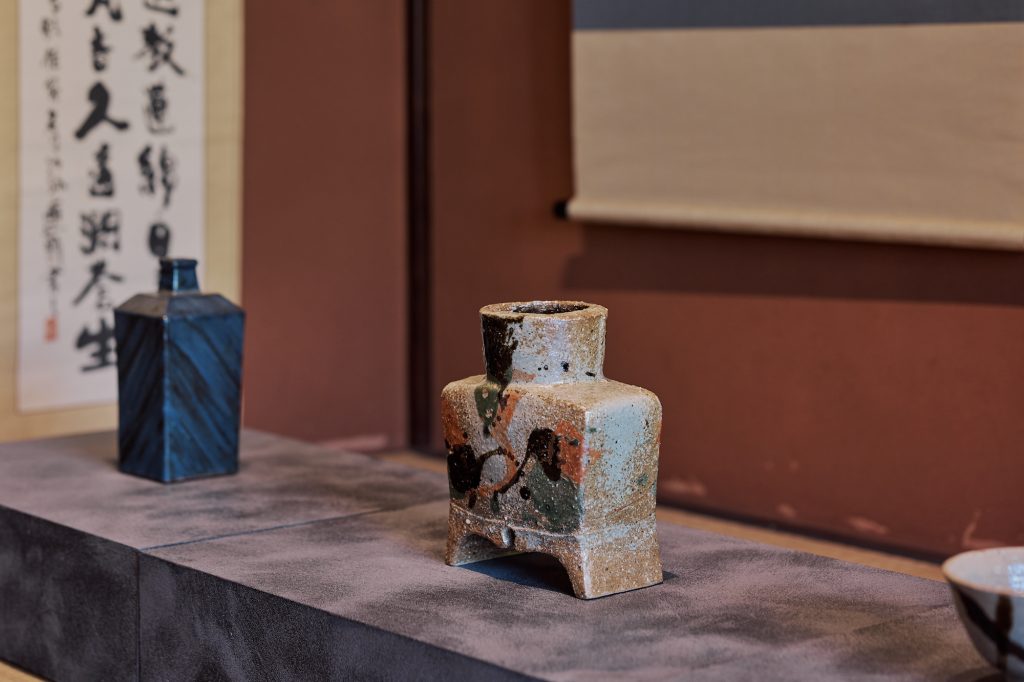
棟方志功が疎開をきっかけに6年8ヶ月の歳月を富山で過ごしたことで、濱田庄司、河井寛次郎、バーナード・リーチ、芹沢銈介ら当時の民藝運動を代表する作家たちが富山を訪れた。棟方も足繁く通っていた当別院には、彼らの作品も多く遺されている。
As a result of his evacuation, Shikō Munakata spent six years and eight months in Toyama. During this time, notable artists representing the Mingei movement of that era, such as Shoji Hamada, Kanjiro Kawai, Bernard Leach, and Keisuke Serizawa, visited Toyama. As Munakata also frequented this temple, many of their works have been preserved.
山門天井画 Main Gate Ceiling Painting
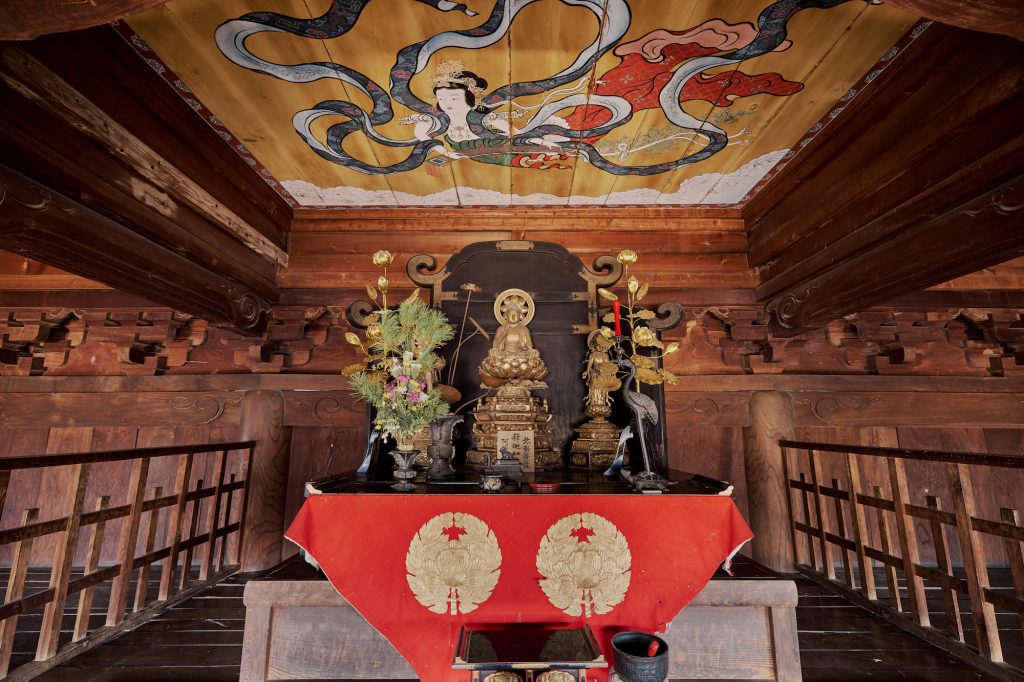
山門は、寛政12年(1800年)より文化12年(1815年 )までの15年の歳月を要して建てられた。楼上には釈迦三尊(左:阿難尊者、中心:釈迦如来、右:弥勒菩薩)が安置され、古文書には当町の信仰厚き女性達が享和2年(1802年)から5年の歳月をかけ、 町、里、村、五箇山、加賀地方まで足を運び懇志を集め、(寄進女性の毛髪を売り)この3体の仏像を寄進し たことが記されている。また、天井には狩野派絵師による天女と迦陵頻伽が描 かれ、200年以上経った現在も色あせる事無く当時のまま残されている。
The main gate was constructed over a period of 15 years from the 12th year of Kansei (1800) to the 12th year of Bunka (1815). Enshrined on the upper floor are three statues: on the left, Ananda, in the center, Shakyamuni Buddha, and on the right, Maitreya Bodhisattva. Historical documents mention devout women of the town who, over five years starting from the second year of Kyōwa (1802), traveled throughout the town, villages, and even as far as the Kaga region and the Gokayama area to collect donations, eventually contributing these three Buddhist statues. Furthermore, the ceiling features depictions of celestial maidens and Karyobinga painted by artists of the Kano school, which have remained unchanged for over 200 years, retaining their original colors and vibrancy.
絵解き Narrating Scroll Paintings
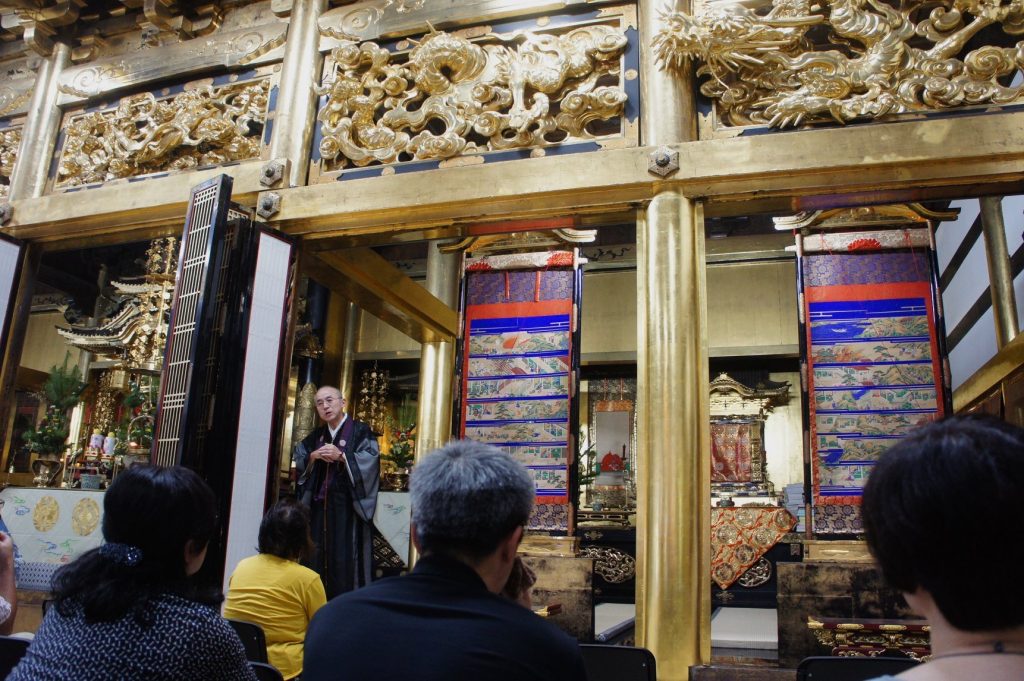
蓮如上人と聖徳太子の生涯を絵物語を使って僧侶が解説する、今では珍しい「絵解き」が虫干法会期間中に行われる。
During the Mushiboshi Houe ceremony, monks engage in a rare practice called “etoki,” where they use the hanging scrolls to explain the lives of Renyo Shonin and Prince Shotoku.
お斎(とき)さば寿司 Otoki – Fermented Mackerel Sushi
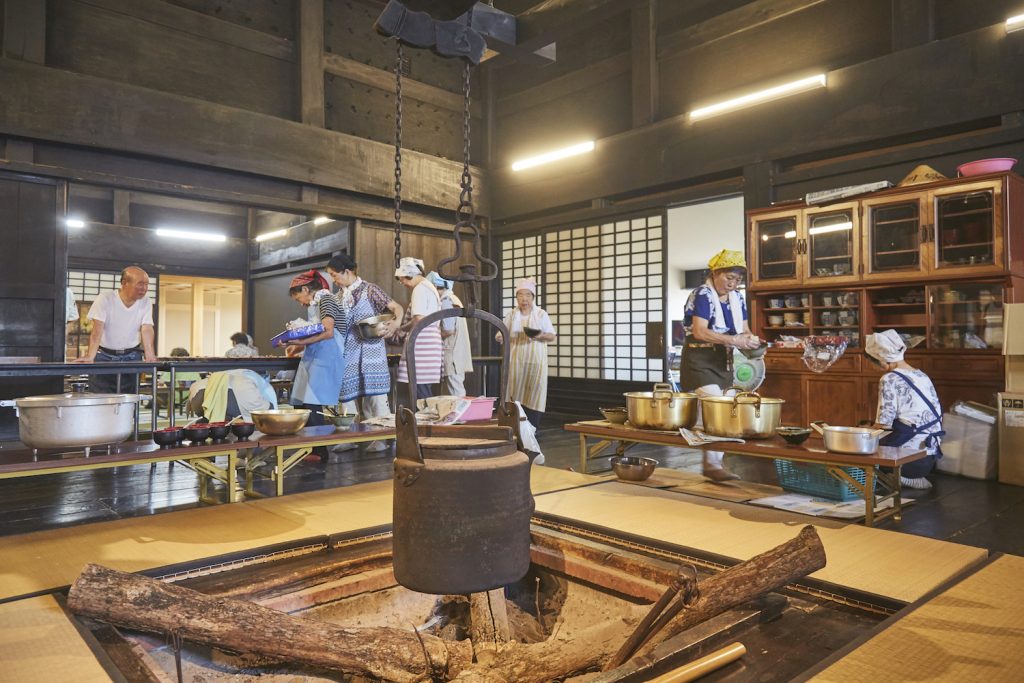
当別院名物として知られる、伝統的な「さば寿し」は、当別院内の小屋で毎年5月下旬に漬けられる。塩さばと炊いたご飯だけで作られる本なれ寿しとして、全国的にも数少ない漬け込み方である。法要の際の食事「お斎」として、このさば寿司が煮物などの郷土料理とともに期間中提供される。
The traditional mackerel marinated sushi, known as the temple’s speciality, made from only salted mackerel and cooked rice, is pickled at the Sabazushi hut in the temple’s premises. Saba-zushi is served during the period as ‘Otoki’, a meal during the Buddhist memorial service, together with local dishes such as simmered vegetables.







